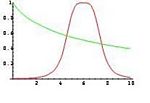Fuzzy subset
To be Completed !!
Introduction
In the everyday activity it is usual to adopt vague properties as "to be small", "to be close to 6" and so on. Now, in set theory given a set S and a "well defined" property P, the axiom of comprehension reads that a subset B of S exists whose members are precisely those objects in S satisfying P. Such a set is called "the extension of P in S". For example if S is the set of natural numbers and P is the property "to be prime", then the subset B of prime numbers is defined. Assume that P is a vague property, then the question arises whether there is a way to define notions as "the subset of small numbers", "the subset of numbers close to 6". An answer to such a question was proposed in 1965 by Lotfi Zadeh and, at the same time, by Dieter Klaua in the framework of multi-valued logic. The idea is to extend the notion of characteristic function.
Definition. Let S be a nonempty set, then a fuzzy subset of S is a map s from S into the real interval [0,1]. If S1,...Sn are nonempty sets, then a fuzzy subset of S1×. . .×Sn is called an n-ary fuzzy relation.
The elements in [0,1] are interpreted as truth degree and, in accordance, given x in S, the number s(x) is interpreted as the membership degree of x to s. We say that a fuzzy subset s is crisp if s(x) is in {0,1} for every x in S. By associating every classical subsets of S with its characteristic function, we can identify the subsets of S with the crisp fuzzy subsets. In particular we call "empty subset" of S the fuzzy subset of S constantly equal to 0. Notice that in such a way different sets have different empty subsets and therefore there is not a unique empty subset as in set theory.
Some set-theoretical notions
In classical mathematics the definitions of union, intersection and complement are related with the interpretation of the basic logical connectives . In order to define the same operations for the fuzzy subsets of a given set, we have to fix suitable operations and in [0,1] to interpret these connectives. Once this was done, we can define these operations by the equations
- ,
- ,
- .
If we denote by [0,1]S the class of all the fuzzy subsets of S, then an algebraic structure is defined. This structure is the direct power of the structure with index set S. In Zadeh's original papers the operations are defined by setting for every x and y in [0,1]:
- ; ; .
In such a case is a complete, completely distributive lattice with an involution. Usually one assumes that is a triangular norm in [0,1] and that is the corresponding triangular co-norm defined by setting . For example, the picture represents the intersection of the fuzzy subset of small number with the fuzzy subset of numbers close to 6 obtained by the minimum and the product. In all the cases the interpretation of a logical connective is conservative in the sense that its restriction to {0,1} coincides with the classical one. This entails that the map associating any subset X of a set S with the related characteristic function is an embedding of the Boolean algebra into the algebra .
L-subsets
The notion of fuzzy subset can be extended by substituting the interval [0,1] by any bounded lattice L. Indeed, we define an L-subsetas a map s from a set S into the lattice L. Again one assumes that in L suitable operations are defined to interpret the logical connectives and therefore to extend the set theoretical operations. This extension was done mainly in the framework of fuzzy logic.
See also
- Fuzzy logic
- Fuzzy control system
- Neuro-fuzzy
- Fuzzy subalgebra
- Fuzzy associative matrix
- FuzzyCLIPS expert system
- Paradox of the heap
- Pattern recognition
- Rough set
Bibliography
- Cox E., The Fuzzy Systems Handbook (1994), ISBN 0-12-194270-8
- Gerla G., Fuzzy logic: Mathematical Tools for Approximate Reasoning, Kluwer, 2001.
- Gottwald S., A treatase on Multi-Valued Logics, Research Studies Press LTD, Baldock 2001.
- Hájek P., Metamathematics of fuzzy logic. Kluwer 1998.
- Klaua D., Über einen Ansatz zur mehrwertigen Mengenlehre, Monatsberichte der Deutschen Akademie der Wissenschaften Berlin, vol 7 (1965), pp 859-867.
- Klir G. and Folger T., Fuzzy Sets, Uncertainty, and Information (1988), ISBN 0-13-345984-5.
- Klir G. and Bo Yuan, Fuzzy Sets and Fuzzy Logic (1995) ISBN 0-13-101171-5
- Kosko B., Fuzzy Thinking: The New Science of Fuzzy Logic (1993), Hyperion. ISBN 0-7868-8021-X
- Novák V., Perfilieva I, Mockor J., Mathematical Principles of Fuzzy Logic, Kluwer Academic Publishers, Dordrecht, (1999).
- Yager R. and Filev D., Essentials of Fuzzy Modeling and Control (1994), ISBN 0-471-01761-2
- Zimmermann H., Fuzzy Set Theory and its Applications (2001), ISBN 0-7923-7435-5.
- Zadeh L.A., Fuzzy Sets, Information and Control, 8 (1965) 338-353.








![{\displaystyle ([0,1]^{S},\cup ,\cap ,-,\emptyset ,S)}](https://wikimedia.org/api/rest_v1/media/math/render/svg/a2c3527a01030236ef22bc844e1d84e265470e6b)
![{\displaystyle ([0,1],\oplus ,\otimes ,\backsim ,0,1)}](https://wikimedia.org/api/rest_v1/media/math/render/svg/8b56b8967cfd4c1e93feda4f866b6a38c0f625e1)








